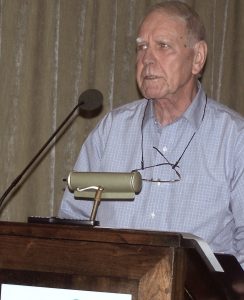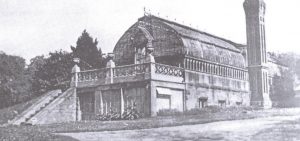Heirlooms: Cornwall Manor’s Greenhouses

Doug and Kathy Powell relocated from Tennessee to Cornwall Manor in June 2014. They chose Cornwall Manor for the ambience. “The campus is beautiful. It reminded me instantly of a college campus. There are a variety of new and historic buildings among tall trees and numerous gardens,” states Doug.
One of those historic buildings is the greenhouse, located on Cornwall Manor’s Buckingham Campus. Constructed in 1881, the greenhouse was built to assist the gardeners in maintaining the estate’s vast grounds. Almost 135 years later, the greenhouse still remains as an historic piece of the “Cornwall Manor story.”
Soon after Doug and Kathy settled into their new home, Doug agreed to chair Cornwall Manor’s Residents Association Garden and Greenhouse Committee – a position he held from August 2014 until December 2015. A fitting position since his second career – which spanned 23 years – included building and operating a commercial greenhouse in Virginia that sold wholesale and retail plants year round.
Doug’s interest in the history of the greenhouse peaked in April 2015 during a program held for residents. Local authors Michael A. Trump and L. Susan Wentzel presented their second book in the series, The Communities of Cornwall Across Time. The second book, A Historic Tour of Cornwall Manor, focused on the Grubb, Coleman, Freeman and Buckingham families that lived in the Buckingham Mansion and owned and operated the Cornwall Iron Furnace to the time that the estate was sold to Methodist Clergy who began a retirement home for retired Methodist clergy and spouses to present day.
“I had to know more,” states Doug. After reading the book, Doug got to work on his own research in February 2016 with the intention of sharing his findings at a program for residents.

In his research he found that Miss Sarah Coleman commissioned Bartlett Hayward and Company to construct the greenhouse, which cost $10,000 in 1881, to complement the estate. The grand conservatory was constructed with a native sandstone foundation, numerous arched glass expanses and capped with ornamental cresting at its rooflines. A massive decorative chimney provided ventilation for the steam heating system. Joseph Ferry served as the estate’s head gardener for over 50 years. After Ferry’s death in 1914, Lester Carpenter oversaw the operations of the greenhouse and what was grown for the estate. The massive steel frame was altered three times since its construction in 1881. Changing tastes and expensive maintenance caused its owners to make alterations to the once massive structure.
The greenhouse was still part of the Buckingham estate when the Methodist clergy purchased the property in 1949, however; it had begun to decline. In the spring of 1956, a much smaller and modern greenhouse was constructed of aluminum and glass and was built for green-thumbed residents. The decision to construct the new structure was more economical than restoring the former greenhouse. Plants raised in the greenhouse were sold at bazaars and planted throughout the grounds.
In the 1970’s curved glass was found in the attic of the Buckingham Mansion and the original greenhouse became usable after the glass was restored. In 1998, resident Marion Hull was the chairperson of the Garden and Greenhouse Committee and headed a task force to find out the best purpose for the greenhouse and how to restore it. Had the time come to tear down the historic ailing greenhouse? No. In 2003, glass panels were installed on the eastern portion and in 2004, low temperature warning lights were mounted. The greenhouse to the east of the boiler house was made handicapped accessible. Today, the greenhouse is going through another “facelift.” Plexiglas panels are being replaced and the exterior structure is being repainted. The greenhouse continues as its original purpose – a space for residents to garden year-round. Cornwall Manor is very fortunate to have this historic greenhouse as part of our beautiful community and for residents like Doug Powell, who remind us of their value and history.

